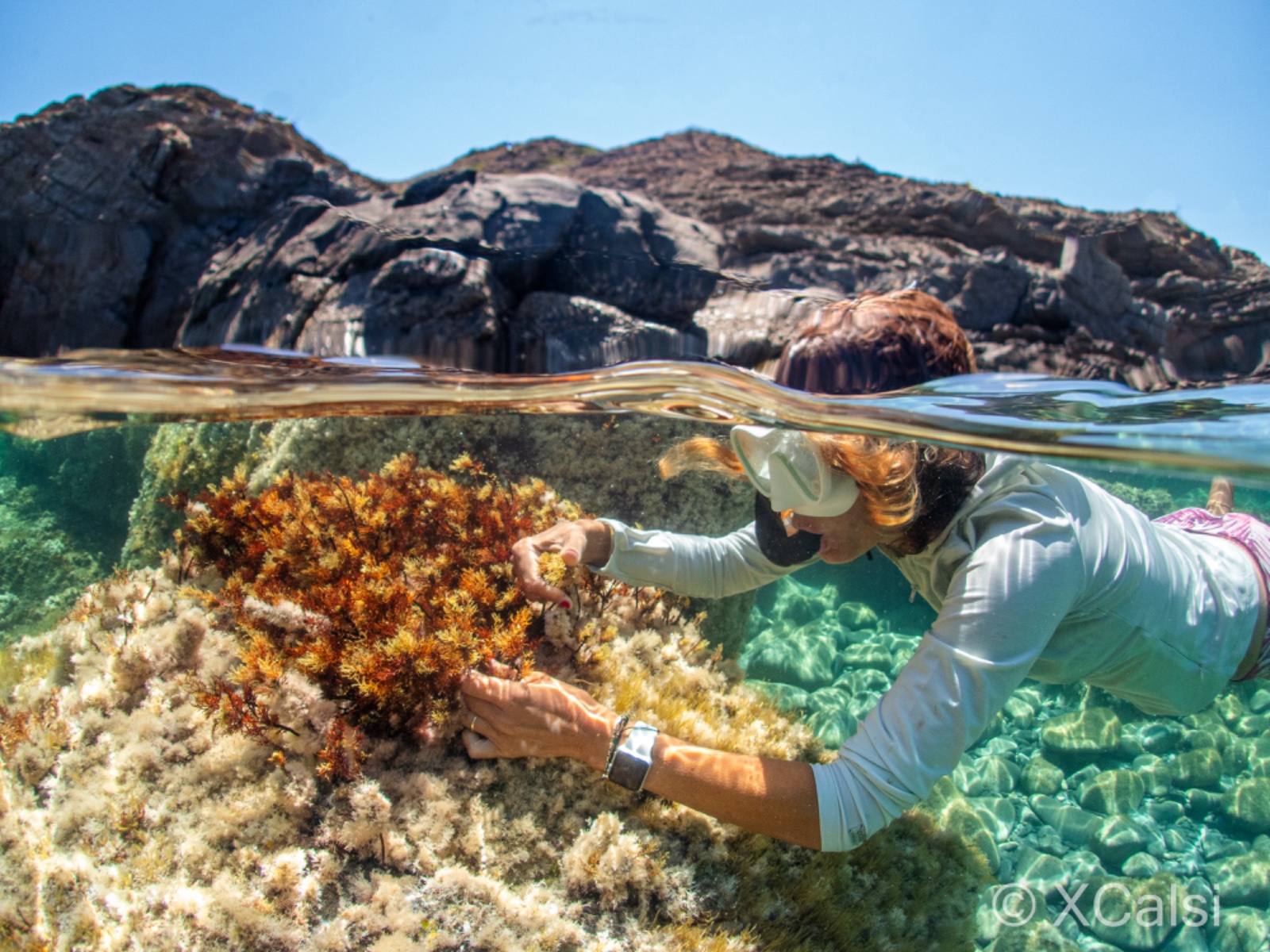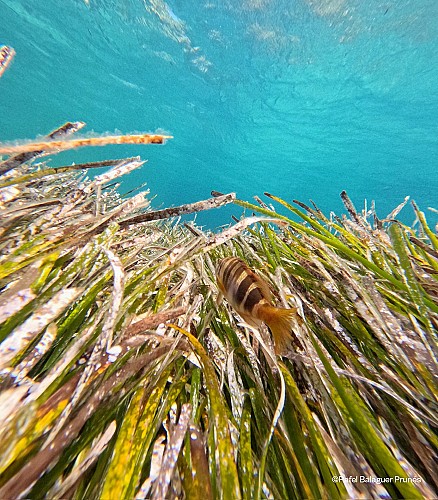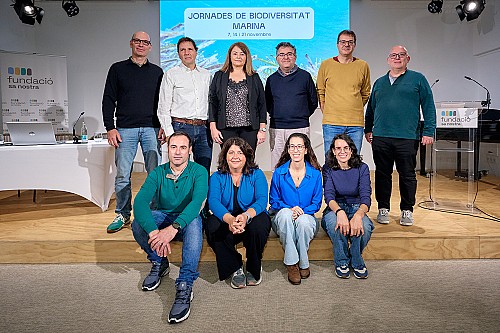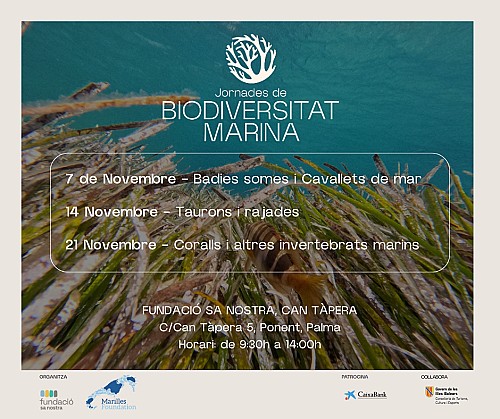Emma Cebrian: "We need to better explain shallow bays and more often"
Published 16.07.2024
Share

Emma Cebrián Pujol (Terrassa, 1975) is a marine biologist specialising in the functioning of benthic ecosystems. She is a researcher at the Centre for Advanced Studies in Blanes (CEAB - CSIC). Since 2020, she has been advising the shallow bay restoration project funded by Marilles and Menorca Preservation and implemented by OBSAM.
What is a shallow bay?
In contrast to highly exposed areas, such as cliffs, shallow bays are calm water spaces where humans feel very comfortable. They may also be natural harbours and are usually highly anthropised. Because they receive plenty of light, they are spaces with a lot of vegetation. For example, we find Posidonia forests that can form barrier reefs and generate lagoons with such particular conditions that communities such as calm Cystocerira forests, Cymodocea meadows, Zostera noltii, and Ruppia can develop in them. A large number of fish fry can live in them, too. In other words, they are areas full of life.
Why have you been working mainly in Menorca on the restoration of shallow bays?
I’ve been working all over the Balearic Islands. However, Menorca has some of the best-preserved shallow bays in the most pristine state in the entire northwestern Mediterranean. Sanitja, Fornells, and Addaia are bays where human development has not destroyed the natural assets.
What are the main pressures or impacts affecting them?
As in all habitats, this is a multifactorial issue. Not all pressures have the same consequences. Where you have a natural harbour, if you start to build docks, boardwalks, and harbours – which is what’s usually done – you lose this habitat; there is no chance of recovery. Another impact can be water pollution, which is also serious, although the sea is very forgiving and, if we work on water purification and improving water quality, it will recover. At this moment, habitat destruction, poor water quality, and over-frequentation are the main pressures on the bays in the Balearic Islands. What’s going to happen in the future? Well, there are other issues, such as climate change and the presence of invasive species.
Which species are most affected by these pressures?
Many. If you talk to specialists from different groups, they’ll list a wide variety of species. One of the main problems, though, is losing the species that give structure to the habitat. If you lose them, you’ll probably also lose all the species that are linked to them.
What does this mean?
I’ll explain it with an example at the terrestrial level: losing a small flower or a very vulnerable bird is a very big loss, but it’s not the same as losing the trees. If we lose the trees we lose everything. In the sea, these ‘trees’ that provide structure are species such as Posidonia, Cystoseira, and Cymodocea.
Do you think that the population knows enough about all this wealth that is hidden in the shallow bays?
Neither scientists nor communicators have been able to explain to the public the great ecological interest of these habitats. Often, the focus is on the areas with large fish and great depths. We’ve not been able to show all these really productive areas, which are so close to us. I think the first time I saw images of shallow bays on television was the episode dedicated to them by Arxipèlag Blau. We still have a lot of work to do. We need to better explain shallow bays and more often. We need the people who live in the area to be aware of what they have next to them, to get closer to them. If they know how unique these spaces are, they’ll be the first to get involved in ensuring that they’re not touched.
In the presentation of the restoration project, you said that Cala Teulera (Mahón) is famous in the scientific world. Why?
In the European Union, there’s a lot of interest in the restoration of communities and habitats. More than 10 years ago, when this subject wasn’t yet being worked on, Marta Sales found that the quality of the water in Cala Teulera had improved. She wanted to restore its population, and it worked! She planted 50 square metres of Gongolaria barbata, which ended up becoming 1,000 square metres. In Cala Teulera, we’ve been able to describe zero-destructive techniques that, as they’ve been successful, have also involved the recovery of the marine forest and all that this means in terms of increased biodiversity, oxygen production, and carbon sequestration. Cala Teulera is the only example that has really worked in the whole Mediterranean.
Is there a need for more involvement of the administration in the protection of these habitats?
Of course, there is. The administration is the only one that can protect the shallow bays, but unfortunately, there are many short-term economic interests. For example, in Cala Teulera they want to build a boat ramp. If the project goes ahead, this space that we have taken years to recover could be destroyed in a day and we will never be able to restore it. It’s clear that there has to be economic development, but it has to be done sustainably. If not, Menorca will not be what it is now. It will not be a biosphere reserve, but just an area like other areas in the Mediterranean. If the administration does not protect it, who will?
Can Menorca's experience be replicated on other islands?
Yes, but we have to be honest about what we can do. There is a very large component of humanisation on all of the islands. Therefore, priority should be given to those that are in the best state of conservation. We won’t go back to the 1950s, but we can maintain areas in an optimal state. And it’s very important that they’re connected and not isolated. If it can be done anywhere, it is in the Balearic Islands.
Can you give us an example of an unrecoverable shallow bay?
Cala Llonga, in Cala d'Or (Mallorca).
Have you always had a connection with the sea? What made you decide to dedicate yourself to its conservation?
I'm from the city. When I was a child, I only saw the sea once a year, when we went on holiday to Llafranc. I saw it in moments of leisure and happiness. I studied biology because I liked nature and I imagined a future in the open air; the speciality that most excited me was the sea. Conservation is a side effect of knowing the sea. If you don't know something it's hard to conserve it or want it conserved. It is part of a process and this is precisely the process that we have to help people get involved in.
QUICK TEST FOR SEA LOVERS
A book: The Clan of the Cave Bear, by Jean Marie Auel.
An image that evokes the Balearic Islands: The turquoise blues of the water and the ochre of the Cystoseira snorkelling on Mongofre beach.
A marine species: Luria lurida.
A person or organisation of reference: Enric Ballesteros.
A beach: Cala Viola de Ponent in the early morning.
Optimistic, pessimistic or realistic? Optimistic. Otherwise, I wouldn't be able to do what I do.




